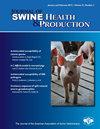适用于猪运输拖车的病原体热灭活的时间和温度要求
IF 0.7
4区 农林科学
Q3 Agricultural and Biological Sciences
引用次数: 2
摘要
目的:生猪运输拖车的生物安全是对病原体在场所之间传播的关注,因此,它们需要在负载之间进行广泛的清洁和消毒。我们在这项研究中的目标是找到在实验室环境中对生产者高度关注的猪病原体进行热灭活所需的最佳时间和温度,然后推断到运输拖车上。材料和方法:采用标准的微生物学技术进行生长和纯化,生产并检测了5种对猪健康重要的细菌和病毒病原体。在实验室中使用几种时间和温度组合测试了这些病原体的热失活。加入粪便来测试生物材料对灭活所需时间和温度的影响。结果:被试病毒和细菌在75°C加热15分钟后完全失活。粪便的存在增加了病原体灭活所需的时间和温度。意义:运输拖车的加热烘烤现在被用作一种有用的工具,以减少通常与猪疾病相关的病原体的传播。然而,操作人员必须确保拖车所有区域持续加热至75°C至少15分钟,以实现可靠的灭活。在热处理之前,清洁拖车起着重要的作用,因为粪便污染的存在会使病原体隔绝,即使在75°C下15分钟也可能无法完全灭活。本文章由计算机程序翻译,如有差异,请以英文原文为准。
Time and temperature requirements for heat inactivation of pathogens to be applied to swine transport trailers
Objective: Biosecurity in swine transport trailers is of concern for spreading pathogens between premises, and as such, they require extensive cleaning and disinfection between loads. Our goal in this study was to find the optimal time and temperature required to heat inactivate swine pathogens of high concern to producers in a laboratory setting to then be extrapolated to transport trailers. Materials and methods: Using standard microbiological techniques for growth and purification, 5 bacterial and 5 viral pathogens important in swine health were produced and tested. Heat inactivation of these pathogens were tested in the lab using several time and temperature combinations. Fecal matter was added to test the effect of biological material on the time and temperatures required for inactivation. Results: Inactivation was complete for viruses and bacteria tested when heated to 75°C for 15 minutes. The presence of fecal matter resulted in increased time and temperature needed for pathogen inactivation. Implications: Heat baking of transport trailers is now being applied as a useful tool to reduce the transmission of pathogens commonly associated with swine disease. However, operators must ensure consistent heating to 75°C for a minimum of 15 minutes in all areas of the trailer for reliable inactivation. Cleaning trailers plays an important role prior to heat treatment, as the presence of fecal contamination will insulate the pathogens and inactivation may not be complete even at 75°C for 15 minutes.
求助全文
通过发布文献求助,成功后即可免费获取论文全文。
去求助
来源期刊
CiteScore
1.80
自引率
0.00%
发文量
29
审稿时长
>36 weeks
期刊介绍:
The Journal of Swine Health & Production (JSHAP) is an open-access and peer-reviewed journal published by the American Association of Swine Veterinarians (AASV) since 1993. The aim of the journal is the timely publication of peer-reviewed papers with a scope that encompasses the many domains of applied swine health and production, including the diagnosis, treatment, management, prevention and eradication of swine diseases, welfare & behavior, nutrition, public health, epidemiology, food safety, biosecurity, pharmaceuticals, antimicrobial use and resistance, reproduction, growth, systems flow, economics, and facility design. The journal provides a platform for researchers, veterinary practitioners, academics, and students to share their work with an international audience. The journal publishes information that contains an applied and practical focus and presents scientific information that is accessible to the busy veterinary practitioner as well as to the research and academic community. Hence, manuscripts with an applied focus are considered for publication, and the journal publishes original research, brief communications, case reports/series, literature reviews, commentaries, diagnostic notes, production tools, and practice tips. All manuscripts submitted to the Journal of Swine Health & Production are peer-reviewed.

 求助内容:
求助内容: 应助结果提醒方式:
应助结果提醒方式:


